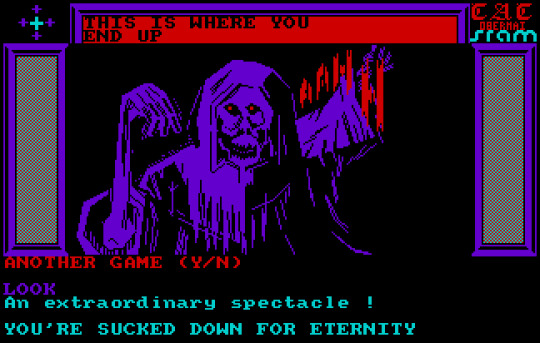#amstrad cpc
Explore tagged Tumblr posts
Text

Wikipedia: Children playing Paperboy on the CPC 464 in 1988
523 notes
·
View notes
Text


Execution (Datacom - Amstrad CPC - 1985)
52 notes
·
View notes
Text

I invite you to our world full of colorful lights, nostalgia for the old days, retro computers, and our amazing models. Check the link and join our retro family!
#zx spectrum#amstrad cpc#retro computing#c64#commodore#commodore 64#commodore amiga#retro gaming#retrofuturism#80s nostalgia#80s vintage#80s aesthetic#retro computers#retro aesthetic#game girl#retro gamer#atari#8bit computers#8bit#neon aesthetic#retro futuristic#pretty girls#beauttiful girls#relaxing#retrowave#vaporwave#vaporwave aesthetic
22 notes
·
View notes
Text
Whopper Chase (ZX Spectrum/Amstrad CPC, Erbe Software, 1987)
You can play this game, which was originally sold with Burger King Whoppers in Spain, in your browser here.
Tip: After the ZX Spectrum version finishes loading and nothing appears, press any key to start the game.

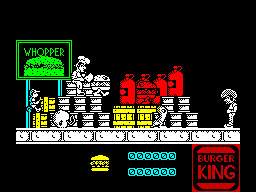
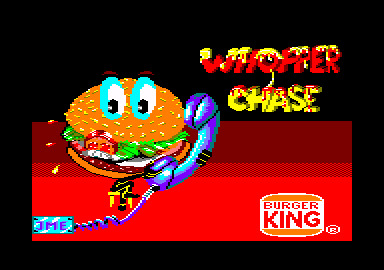
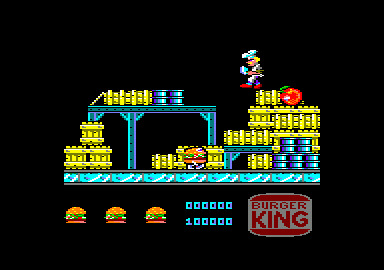

#internet archive#in-browser#zx spectrum#amstrad cpc#game#games#video game#video games#videogame#videogames#computer game#computer games#platformer#platformers#platform games#obscure games#burger king#whopper#licensed games#retro games#retro gaming#retro graphics#game music#video game music#game history#video game history#gaming history#1987#1980s#80s
27 notes
·
View notes
Photo

The Duel: Test Drive II 🏢 Distinctive Software 📅 1989 🖥 Amiga, Amstrad CPC, Apple IIGS, Atari ST, Commodore 64, DOS, MSX, Mac, Mega Drive, SNES... #videogames
29 notes
·
View notes
Text

'Don Quijote: La Aventura'
[C64 / CPC / SPEC] [SPAIN] [MAGAZINE] [1987]
"Don Quijote de la Mancha is an animated television series based on [the acclaimed novel of the same name.] It aired on Televisión Española (TVE) in 1979. It was a huge success among young audiences at the time. As a result, it was broadcast in many countries in the Americas, Asia, and Europe. It was a huge success with both critics and audiences thanks to the clarity of the drawings and its fluid and engaging narration. The series' producers, Cruz Delgado and José Romagosa, never worked together again, and the production company they created to develop the series disappeared once its run ended. The series had a final budget of 11 million pesetas." (€66,111 / $74,381, adjusted for inflation) ~es.wikipedia (Based on Machine Translation)
Source: Micromanía, September 1987 (Vol. 03, #27) || Internet Archive; Archivo Digital
#gaming#advertising#don quijote#don quixote#text adventure#licensed#tie-in#dinamic#spain#commodore 64#zx spectrum#amstrad cpc#1987#computer games
19 notes
·
View notes
Text

Remember when Boots sold home computers?
13 notes
·
View notes
Text






Enterprise 64/128 (1985) (formerly ELAN 64/128)
After the 1982 introduction of the ZX Spectrum, Hong Kong trading company Locumals commissioned Intelligent Software to develop a home computer in the UK. During development, the machine had the codename DPC. The machine was also known by the names Samurai, Oscar, Elan, and Flan before the Enterprise name was finally chosen. The succession of name changes was mainly due to the discovery of other machines and companies with the chosen name.
The Enterprise has a 4 MHz Z80 CPU, 64 KB or 128 KB of RAM, and 32 KB of internal read-only memory that contains the EXOS operating system and a word processor. The BASIC programming language was supplied on a 16 KB ROM cartridge, it had to be inserted into the left side of the machine. Cartridges containing other programming languages (Forth, Lisp, Pascal) were also produced. In this way, games or user programs could be stored on the cartridges. The maximum supported ROM size of the cartridges was 64Kb.
Two application-specific integrated circuit (ASIC) chips take some of the workload off of the central processor. They are named 'NICK' and 'DAVE' after their designers, Nick Toop, who had previously worked on the Acorn Atom, and Dave Woodfield. 'NICK' manages graphics, while 'DAVE' handles sound and memory paging. The Z80, like all 8-bit CPUs, could only address 64 KB of memory, so "bank switching" was required to access more memory. The Enterprise's memory can be expanded to 4 MB without any tricks (and this is a 'plain' 8-bit machine like the ZX-Spectrum or Commodore 64)
Enterprise was announced to the press in September 1983, and some 80,000 machines were pre-ordered by the time of its April 1984 sales launch. The product did not ship until 1985, by which point the UK home computer market was already dominated by the ZX Spectrum, Commodore 64, Amstrad CPC, and Acorn BBC Micro with the 16-bit era on the horizon (Commodore Amiga, Atarti ST, etc)
After the initial manufacturing run of 80,000 units, it is believed that no further units were made, so the Enterprise is among the rarer home computers of the 1980s.
source of images: 8bit home computer museum
more info: https://en.wikipedia.org/wiki/Enterprise_(computer)
https://www.theregister.com/2013/10/24/elan_flan_enterprise_micro_is_30_years_old/
#enterprise128#enterprise64#elan128#elan64#8bit#z80#british 8bit#retrocomputing#retro computing#retro gaming#retrogaming#zx spectrum#commodore 64#amstrad cpc#BBC micro#gif#80s#80s computer#vintage computer#computers
12 notes
·
View notes
Text

amstrad cpc (colour personal computer)
176 notes
·
View notes
Text

Tales Of The Unknown: Volume I: The Bard’s Tale
Developed/Published by: Interplay Productions / EA (original), Krome Studios / InXile Entertainment (remaster) Released: 12/1985 Completed: 05/02/2025 Completion: Finished it.
I’ve been itching to play an old school western RPG recently–really want to see some numbers go up–and got really excited when I discovered The Gold Box Companion, a companion app for SSI’s legendary Dungeons and Dragons RPGs that–because I was too young for them at the time–completely passed me by.
However… I couldn’t help but feel I’d be skipping a bit too far forward on my (personally imposed) chronology if I jumped to playing Pools of Radiance–I wasn’t satisfied when I played Pirates! that I had the historical context I wanted–that I nosed around a bit to see if there was something I’d previously skipped that might fit the bill.
Hence: The Bard’s Tale.
Now, I’d previously skipped this because I’d heard that it was, frankly, a bit boring. Actually, I was basing that entirely on The Digital Antiquarian saying “long before the end of the first Bard’s Tale it’s starting to get a bit tedious” which probably isn’t entirely fair. But what drew me back was that The Bard’s Tale is one of those games that I think many who grew up in the “video game magazine” generation have–a game that I read about two sentences about but was always longing for.
It’s funny the things that lodge in your mind, isn’t it? Here’s the reader’s letter from Amstrad Action that’s stuck with me since literally 1991:

“Well, if this dork wants it so badly, it must be great!”
What’s funny is that in the intervening, uh, thirty years [“lies. The 90s are ten years ago”–Ed.] I managed to forget, I guess, that Amstrad Action’s “Balrog” ran an entire “The Bard’s Tale Club” section culminating with a short walkthrough just a few issues earlier.
Interestingly, I think this is one of those things where I can see myself maturing in real time–in the matter of months I went from a wean who skipped the Balrog section because it wasn’t about, like, arcade games, to a wee guy who was at least interested in them. That or a guy pretending to be a gnome caught my eye.
All I remember is that I’d missed my chance to get The Bard’s Tale. So, here I am, thirty [“ten… I’ll go as far as fifteen”–Ed.] years later, finally living my childish dreams.
First: if I’d got this in 1991 I’d have been completely baffled by it. Within a few short years I’d be playing Ultima Underworld, but I didn’t really even play that properly, and The Bard’s Tale requires, like Wizardry, a deep understanding of RPG character creation and party management. And also like Wizardry, it’s about as brutal as an RPG can get, killing your party or giving them debilitating, expensive-to-cure status effects that require you shlep all the way back to a temple to solve, in maps that wrap (no! Not again!!!) and are absolutely louping with spinners, traps and dark zones.
In some respects, I’m lucky that I mostly relied on luck and parental largesse to get computer games.
I’m also lucky that there’s a remake of The Bard’s Tale in the form of Krome Studios’ The Bards Tale Trilogy: Remastered, which rights-holder InXile Entertainment had them make (after, interestingly, a remaster from the team of one of the original developers, Rebecca Heineman unfortunately fell through). I’ll be honest, I was originally not planning on playing it, because it has genuinely awful Super2xSal-quality upscaled art. The game looks like this:

When in its best contemporary ports, it looked like this:

I know which I’d rather look at, though in some respects I thank god that the remake came out before they could us AI to upscale it all and make something that looked even worse. The benefit of playing this (nasty) looking versions outweigh the pain of looking at it though, because not only does it make a lot of quality of life improvements such as a shared inventory and doubled experience, it plays perfectly with a controller–so you can even play it with a Steam Deck comfortably.
If you’re a purist, however (and I don’t actually blame you) I have to admit that the version I played isn’t exactly The Bard’s Tale, as the “trilogy” version aligns all three games design, so in this version there are distance mechanics in the combat (enemies can start some distance from you and you have to advance on them) and bows and arrows are added, which I suspect changes the feel of the combat quite a bit. But to be honest, I can live with it. And I never used bows and arrows anyway.
Enough personal history. For the real history, you can of course go to someone like the aforementioned Digital Antiquarian, but it’s worth noting that even though The Bard’s Tale entered my own personal history in 1991, it was released in 1985 and is, I think surprisingly to modern eyes, the best selling computer RPG of the 1980s, selling a reported 407,000 copies.
I say surprisingly because The Bard’s Tale hasn’t lingered in the cultural imagination the way that RPGs such as Wizardry or Ultima have. It wasn’t first; it didn’t inspire much (Japanese RPGs were already divergent by 1985) and the series didn’t evolve any better than Wizardry did. By 1991, the year I discovered it, a cash-in construction set was released for anyone who hadn’t already moved on to the more active style of dungeon crawler begat by Dungeon Master, and it wouldn’t be seen again until The Bard’s Tale in 2004, which is a Bard’s Tale game in name only.
If you’re wondering what made The Bard’s Tale so successful, but then so irrelevant, it comes down to the fact that it is, ultimately, just a Wizardry clone that happened to come out on the popular C64 with nicer graphics than Wizardry years before Wizardry would reach the system, and be pushed by the already mature (and not yet fully soulless) EA.
Designed by Michael Cranford, it was his second attempt to directly make a Wizardry killer after HesWare’s apparently flawed Maze Master. For some reason, The Bard’s Tale is particularly known for the development team all sniping at each other publicly for years after the game’s launch (it even makes the Wikipedia) but it’s all so “he said, she said” and feels kind of… un-illuminating about the game. At least, it doesn’t add anything. The only part I find particularly interesting is that this game is officially called “Tales Of The Unknown: Volume I: The Bard’s Tale” because (and there is some argument over this) the series was supposed to be called “Tales Of The Unknown” but–and this might be a sign of EA’s encroaching soullessness–it was felt “The Bard’s Tale” was better known, so it got dropped.
(And if you’re wondering why I find that interesting, it’s because it would happen again with The Legend of Kyrandia, which was actually supposed to be the “Fables & Fiends” series. I’m not sure how many more examples of this there are.)
Anyway. As I said above, writing about the experience of playing The Bard’s Tale feels almost exactly like writing about Wizardry, bar for a few twists (I like to believe if they’d kept to “Tales Of The Unknown” maybe the sequels would have diverged more.) The main twist people get excited about is that you navigate the town in the same way that you navigate the dungeons (step-by-step 3D movement) but let me tell you this–it just means you have to do an annoying amount of schlepping about and fighting piddly enemies when you want to heal or level up, and I’d honestly rather a menu. The thing I felt like I felt I did the most in The Bard's Tale was stand around outside the "Review Board" save scumming to try and make sure my level up rolls were good...
The rest of the game, despite featuring several dungeons, ultimately boils down to what you’ll do in Wizardry–try and find the best way to grind so you can kill the final boss. In the original game, this was a particular repeatable battle, which led to one of my best ever “this is too specific, that’s not how memes work” memes, clattering out to complete silence:

But in the remake, which has a smoother curve (and only lets you do this battle once) you can get away with just ordinary grinding (thankfully). Now, the game does actually feature some puzzle solving–you do have to find and collect certain items–but moreso than Wizardry, I realized how much I miss a “proper” quest and side-quest system. Here you have to notice text prompts when you step in certain squares (which zoom off the screen immediately in the remake which means you’ll never see them–a big mistake) and piece them together, but getting deeper into dungeons is grimly unrewarding when that’s all you get. I started my game mapping this properly, but the maps get worse than Wizardry even faster! So much of the dungeons in this game are made up of "dark" squares that you feel like you're navigating almost the entire game blind, to the point where I almost can’t imagine trying to complete this without having another map at hand and the in-game automap (I can hear the hardcore crusty RPG types rolling their eyes here…)
It could be alleviated, perhaps, if you could enjoy the combat, but there is almost no strategy to it. While it may partially be a flaw of the remake (where the updates fly off the screen at a hundred miles an hour) The Bard’s Tale has a bizarre difficulty scaling where you start by having your entire team killed by a single mouse holding a feather duster and about an hour later are fighting a squad of forty vampires at once. While it’s extremely funny to imagine them trying to all squeeze into a corridor, the problem is that your melee characters are just meat shields for your magic users. I made myself up the kind of squad that gets recommended for The Bard’s Tale and as much effort as I put into my critical-hit focused “Hunter” character (usually my favourite kind of RPG character! I love them crits!) I barely noticed them doing anything at all with their piddly single hit on one enemy compared to my magic users, who by mid-game have a spell that can wipe out every enemy you're facing in a battle at once.
The game’s focus on the magic users makes it seem even odder that the series ended up going under The Bard’s Tale moniker. While your melee types are stuck in their starting class, your magic users are expected to change class each time they fill their classes’ spellbook, and they start again from level one keeping all their stats (quite unlike Wizardry…) meaning that by the end of the game you have spellcasters who look like Arnold Schwarzenegger in his prime hiding behind a flesh wall. The only reason you can’t ignore melee completely is that your magic users' armour class is so bad–and that matters when you’re facing off against four squads of sixty enemies at least some of whom might get an individual hit off each before you’re able to hit them with the equivalent of a nuclear bomb.
(This magic user focus is symbolic of author intent, however. As Michael Cranford would explain in his GDC post-mortem of The Bard's Tale and its sequel, he was "bored" by melee combat and was interested in making a game with seven different spell-casting classes that your characters would learn until they were able to become archmages, with melee combat your fallback when you ran out of mana. Although this was cut back to four classes with the archmage showing up in the sequel, this original idea explains everything about why The Bard's Tale plays the way it does.)
But let’s be real here: the majority of The Bard’s Tale you spend not save-scumming level ups to make sure your spell-casters can mow down enemies like they’ve got a gatling gun is spend stumbling around in the dark or in battles you barely notice happening. The only real moments of tension are when you get given one of the many annoying status effects (reload–it’s not worth the hassle) or when you have to get out of the dungeon, because the game (sort of interestingly?) gives you absolutely no way to regenerate mana unless you're outside*, so your grinding sessions are always limited by how long your mana lasts. But because you get so many level-ups with your magic users, it’s not much of a problem (by the middle of the game, I was staying down collecting three or four level ups before bothering to climb back out of a dungeon.)
*You can find magic items that let you regenerate mana in dungeons but I never found any. And there's the occasional regen spot in a dungeon, but I only found a couple. So the point stands, largely.
The problem, sometimes, with playing a game like this is that devoid of the context–an old home computer, months of free time, it being the fucking 1980s–you play it as the object it is, rather than the experience it represented. Everything I’ve said is all true, but if you were loading this up on your C64 (or Amstrad!) with a bundle of paper maps in front of you and the latest “Bard’s Tale Club” tips, nursing your RPG party across months, slowly getting deeper into each dungeon, finding and writing down all the clues, I can see The Bard’s Tale as the evolution–a small evolution, but an evolution–of the Wizardry design it is.
You could recreate this if you really wanted! But the problem is that there are simply more fun, deeper, more interesting, less punishing ways to spend your time not even now–even then. Playing the first The Bard’s Tale, the same as playing the first Wizardry, you understand why they died out so quickly for not adapting. When they aren’t all you’ve got, they aren’t what you want.
The funny thing is, that I’ll still remember The Bard’s Tale fondly. Not for when I played it–but when I imagined it.

It looked like this on the CPC, too. Still better.
Will I ever play it again? You can continue the series seamlessly in The Bard’s Tale Trilogy, but the dungeons in the first game are so horrible I would never do this to myself.
Final Thought: Alright, you’ve read everything I’ve written and you still want to play this. You want to say you’ve played the most important RPGs! I get it. Well, for just $1 you can support my ko-fi and get access to my article on How to beat The Bard’s Tale!
Every Game I’ve Finished 14>24 is OUT NOW! You can pick it up in paperback, kindle, or epub/pdf. You can also support Every Game I’ve Finished on ko-fi! You can pick up digital copies of exp., a zine featuring all-exclusive writing at my shop, or join as a supporter at just $1 a month and get articles like this a week early.
#video games#games#gaming#the bard's tale#ea#interplay#1985#review#amstrad cpc#amstrad action#the balrog#i think you should leave
7 notes
·
View notes
Text

#do you know this game#lemmings#Amiga#MS-DOS#MacOS#Atari ST#ZX Spectrum#CDTV#Acorn Archimedes#PC-98#FM Towns#X68000#Super Nintendo Entertainment System#PC Engine#Mega Drive#Game Gear#Amstrad CPC#Master System#Nintendo Entertainment System#Commodore 64#3DO Interactive Multiplayer#Atari Lynx#SAM Coupé#Game Boy#CD-i#Amiga CD32#J2ME
17 notes
·
View notes
Text

Climb-It (Quellesoft - Amstrad CPC - 1984)
96 notes
·
View notes
Text

We're launching another edition of limited postcards 👻👽 If you're interested, send me a DM
#commodore#commodore 64#commodore amiga#commodore64#c64#retrogaming#retro computing#vintage tech#atari#zx spectrum#amstrad cpc#postcards#postcard#retro collection#80s#80s nostalgia#80s aesthetic#80s girls#80s tech#80s vibes#1980s#8bit computer
36 notes
·
View notes
Text
The Trap Door & Through the Trap Door (C64/Amstrad CPC/ZX Spectrum, 1986/1987)
You can play them in your browser here. (C64 controls include numpad 84620.)
Oo-arr, the original cartoon's finally on streaming!


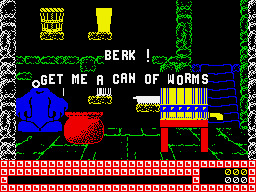
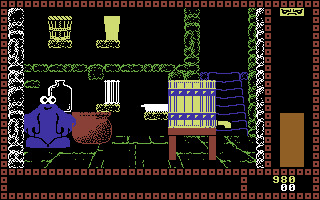
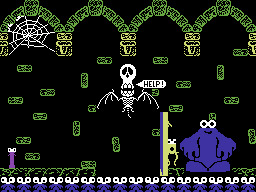
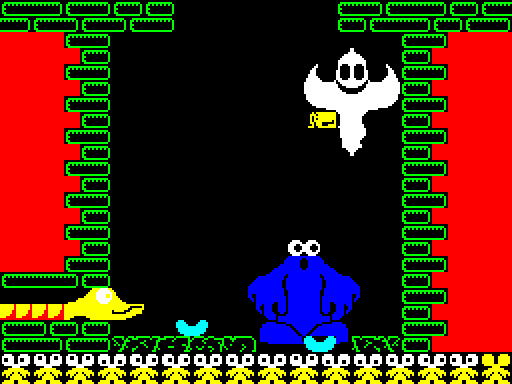
#internet archive#in-browser#c64#commodore 64#amstrad#amstrad cpc#zx spectrum#game#games#video game#video games#videogame#videogames#computer game#computer games#licensed games#weird games#trap door#the trap door#retro games#retro gaming#retro graphics#chiptune#chiptunes#game history#gaming history#1986#1987#1990s#90s
27 notes
·
View notes
